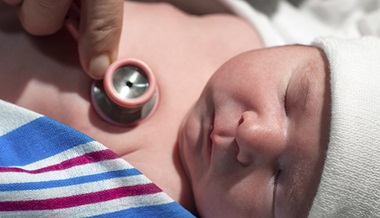Atrial Septal Defect and Ventricular Septal Defect in Children
Featured Experts:
Some children are born with a heart condition called a septal defect. This means there’s a hole in the wall that separates the heart’s four chambers. While this can be a scary diagnosis for any parent to hear, it’s important to keep in mind that the condition is treatable.
Here is a quick explanation of how the heart chambers work:
- The two upper chambers are the atria.
- The two lower chambers are the ventricles.
- The right chambers get oxygen-poor blood from the body and pump it to the lungs to pick up oxygen.
- The left chambers get oxygen-rich blood from the lungs and pump it out to the rest of the body.
In a healthy heart, the wall that separates the right and left chambers (the septum) prevents nonoxygenated blood from mixing with oxygenated blood. A septal defect allows blood to flow back and forth between the right and left sides of the heart.
“When there’s a hole in the heart, either at the atrial or ventricular level, the heart just can’t work efficiently,” explains Benjamin Barnes, a pediatric cardiologist at the Blalock-Taussig-Thomas Pediatric and Congenital Heart Center. The lungs end up getting too much oxygen-rich blood, which makes both the heart and lungs work harder.
What is ASD?
An atrial septal defect (ASD) is a hole in the wall between the heart’s two upper chambers. ASD is a congenital condition, which means it is present at birth.
“Over time, ASD causes stress on the heart, and can cause the right atrium, ventricle and pulmonary arteries to become enlarged,” says James Thompson, M.D., who specializes in pediatric interventional cardiology at Johns Hopkins All Children’s Hospital in St. Petersburg, Florida. ASD may lead to pulmonary hypertension, heart rhythm abnormalities or heart failure.
There are four main types of atrial septal defects.
Secundum atrial septal defect: This is an opening in the middle part of the atrial septum. It is the most common type of ASD.
Primum atrial septal defect: This opening occurs in the lower part of the atrial septum, close to the tricuspid valve (which allows blood flow from the right atrium to the right ventricle) and mitral valve (which separates the heart’s upper and lower left chambers).
Sinus venosus atrial septal defect: This opening occurs in the upper part of the atrial septum, near the veins that flow into the right atrium.
Coronary sinus atrial septal defect: This opening occurs in the wall between the coronary sinus (a large vein that returns blood to the right side of the heart so it can pick up oxygen) and the left atrium. This is the rarest form of ASD.
What is VSD?
A ventricular septal defect (VSD) is a hole in the wall between the two lower chambers. In children, a VSD is usually congenital.
Symptoms of ASD and VSD
A very small hole in the heart may not cause any issues. However, a large hole is usually diagnosed soon after birth because it causes symptoms, Barnes says. “Most ventricular septal defects are picked up by pediatricians when they do newborn exams. ASDs can be more difficult because they don’t always have easy symptoms to look for.”
Symptoms of septal defects in babies include:
- Abnormal heartbeat
- Fast breathing
- Poor growth
- Trouble eating
In older children and adults, symptoms can include:
- Fatigue
- Heart palpitations
- Inability to exercise
- Shortness of breath
- Stroke
Diagnosing a Septal Defect
If a pediatrician or pediatric cardiologist suspects a child has ASD or VSD, the condition can usually be confirmed with an echocardiogram or a bubble study.
Echocardiogram
An echocardiogram, or a heart echo, is an ultrasound that shows how blood flows through the heart. It can help a cardiologist diagnose the location and size of the defect. A fetal echo can even diagnose a septal defect before birth.
Bubble study
If doctors want to rule out even a tiny hole, they can do a test called a bubble study. A cardiologist injects sterile water containing many tiny microbubbles into a vein in the arm. The water makes its way to the heart. On an ultrasound, bubbles in the water show up as white. The doctor can see how the bubbles flow through the heart with the blood. A bubble study is typically done on older children or adults and may require sedation.
Treatment for Atrial Septal Defect and Ventricular Septal Defect
A septal defect doesn’t always need treatment. If the hole is small and not causing serious symptoms or lowering a child’s quality of life, it can simply be monitored over time. Septal defects can also close on their own as a child grows. “This will usually happen if the defect is located in the part of the septum that’s all muscle,” Barnes adds.
If a hole hasn’t closed on its own within a child’s first two years, or if the hole is larger than 8-10mm, surgery may be necessary. If large holes aren’t closed, there can be long-term consequences from damage to the lungs.
The most common procedures for a septal defect are transcatheter repair and open-heart surgery.
Transcatheter repair
A transcatheter repair, also called transcatheter device closure, is usually recommended for an atrial septal defect. During this procedure, a pediatric interventional cardiologist makes an incision in the groin, inserts a catheter, and funnels a small mesh patch through the catheter and up to the hole in the heart. Over time, the child’s own heart tissue grows over the patch.
Learn more about atrial septal defect transcatheter repair for children.
Open heart surgery
A ventricular septal defect is usually repaired with an open surgery, though some children may be candidates for a less invasive procedure. During open VSD surgery, the surgeon accesses the heart by opening the sternum (breastbone). A patch is applied to the septal defect. As with a transcatheter repair, the heart’s own tissue eventually grows over the patch. Open heart surgery is also necessary for ASD that cannot be repaired with a transcatheter device.
Learn more about ventricular septal defect surgery for children.
Life After Septal Defect Treatment
Most children only need one surgery to correct a septal defect. The patch can stay in place for the rest of the child’s life. The positive effects of septal defect correction happen immediately after surgery. “If the babies are having trouble feeding, they feed much better after surgery,” says Barnes. “They gain weight more easily. If a child’s activity level isn’t great before surgery, it’s usually much better after surgery.”
Lifelong follow-up care is necessary after septal defect surgery. When children reach adulthood, they can be transitioned from a pediatric cardiologist to a heart doctor who specializes in adult congenital conditions.








